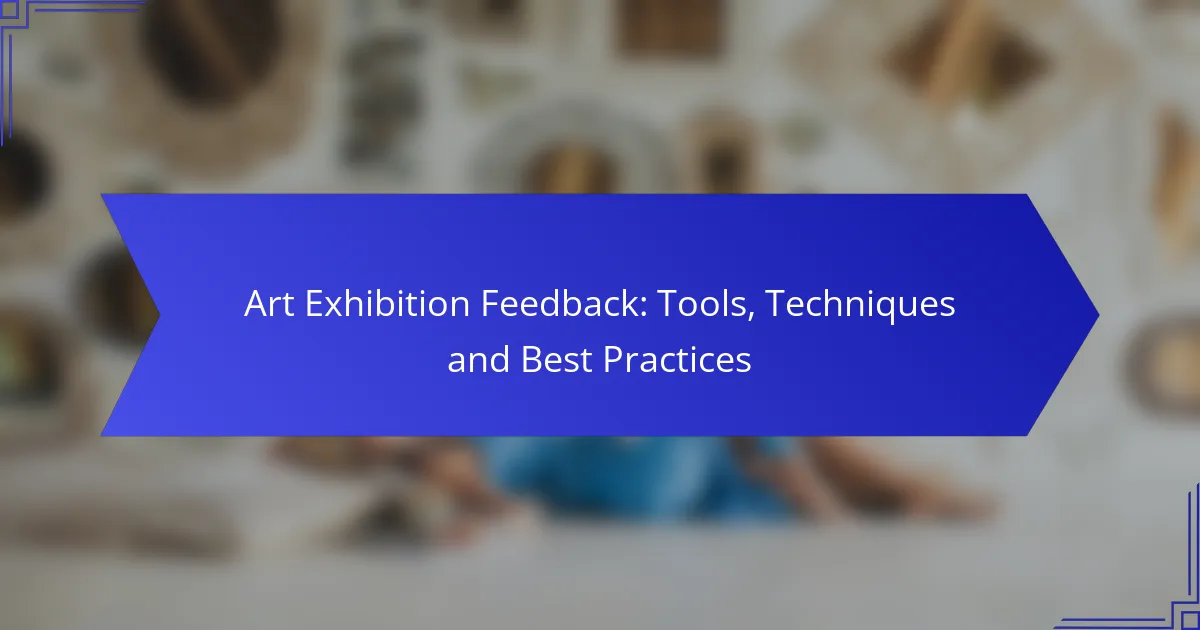Collecting and analyzing feedback from art exhibitions is essential for improving future events. By utilizing various tools and techniques, organizers can streamline the feedback process and encourage attendees to share their honest insights. Implementing a mix of methods, such as open-ended questions and focus groups, can lead to more actionable responses that enhance the overall exhibition experience.
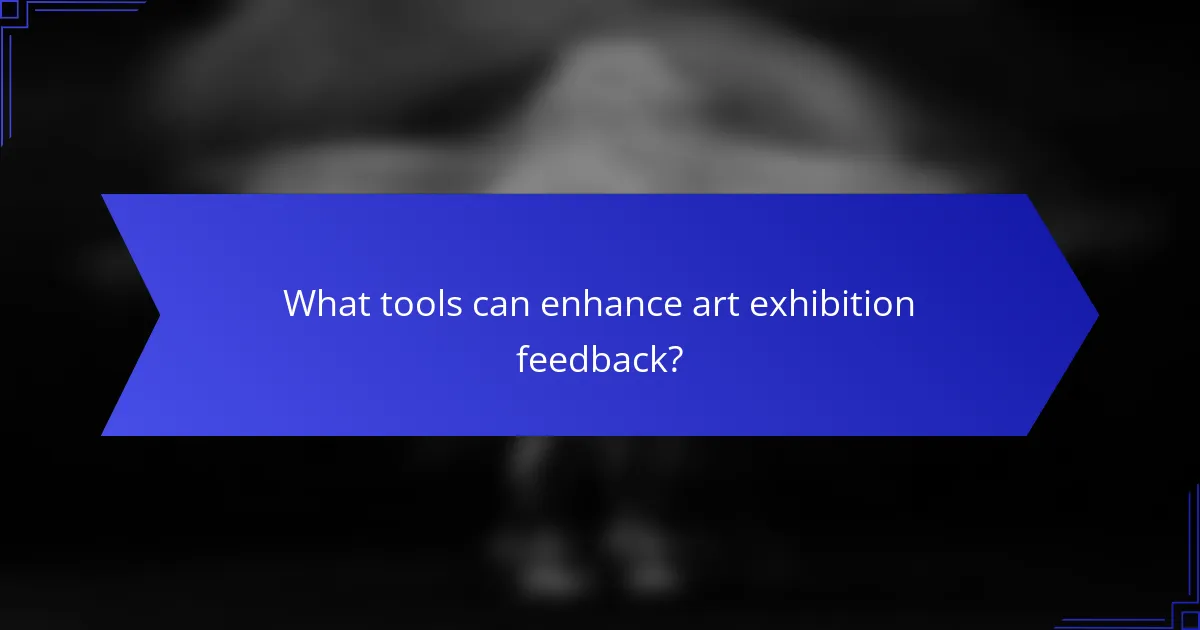
What tools can enhance art exhibition feedback?
Several tools can significantly improve the collection and analysis of feedback from art exhibitions. These tools streamline the process, making it easier to gather insights and enhance future events.
SurveyMonkey for audience insights
SurveyMonkey is a powerful tool for collecting audience feedback through customizable surveys. It allows you to create tailored questionnaires that can address specific aspects of the exhibition, such as visitor experience and artwork appreciation.
Consider using features like branching logic to guide respondents through relevant questions based on their previous answers. This can help you gather more nuanced insights and improve response rates.
Google Forms for easy data collection
Google Forms offers a straightforward way to collect feedback without any cost. Its user-friendly interface allows you to create surveys quickly and share them via links or QR codes at the exhibition.
Responses are automatically compiled in Google Sheets, making data analysis simple. You can utilize various question types, including multiple-choice and open-ended responses, to gather diverse feedback.
Eventbrite for ticketing and feedback integration
Eventbrite not only facilitates ticket sales but also integrates feedback collection seamlessly. After attendees purchase tickets, you can send follow-up surveys to gather their impressions of the exhibition.
This integration ensures that you capture feedback from a targeted audience who has engaged with your event, providing valuable insights into their experiences and preferences.
Artlogic for exhibition management
Artlogic is designed specifically for galleries and artists, offering tools for exhibition management and visitor engagement. It allows you to track visitor interactions and gather feedback directly through its platform.
Using Artlogic can help you analyze visitor data over time, enabling you to refine your exhibitions based on past performance and audience preferences.
Social media platforms for real-time feedback
Social media platforms like Instagram and Facebook are excellent for obtaining real-time feedback during an exhibition. Encourage visitors to share their experiences and tag your exhibition, creating an interactive dialogue.
Monitor comments and messages to gauge audience reactions and address any concerns promptly. This immediate feedback can be invaluable for making on-the-spot adjustments and enhancing visitor satisfaction.

How to effectively gather feedback from attendees?
To effectively gather feedback from attendees, implement a combination of methods that encourage honest and constructive responses. This approach ensures you capture a comprehensive view of their experiences and suggestions for improvement.
Utilize post-event surveys
Post-event surveys are an efficient way to collect structured feedback from attendees after the exhibition. These surveys can be distributed via email or through online platforms, allowing for easy access and completion.
Consider including a mix of multiple-choice questions and open-ended responses to gather quantitative data and qualitative insights. Aim for a completion time of around 5-10 minutes to maximize response rates.
Conduct live Q&A sessions
Live Q&A sessions provide an interactive platform for attendees to voice their opinions and ask questions directly. Hosting these sessions shortly after the event can capture immediate impressions while they are still fresh.
Encourage participation by promoting the session in advance and considering incentives, such as small giveaways, to boost attendance. Be prepared to address both positive and negative feedback constructively.
Implement feedback kiosks at the venue
Feedback kiosks placed strategically around the venue can capture attendee impressions in real-time. These kiosks can feature tablets or touch screens where visitors can quickly rate their experience or leave comments.
Ensure the kiosks are user-friendly and positioned in high-traffic areas to maximize engagement. Providing a simple rating system (e.g., 1 to 5 stars) can facilitate quick responses while still allowing for detailed feedback through comment sections.
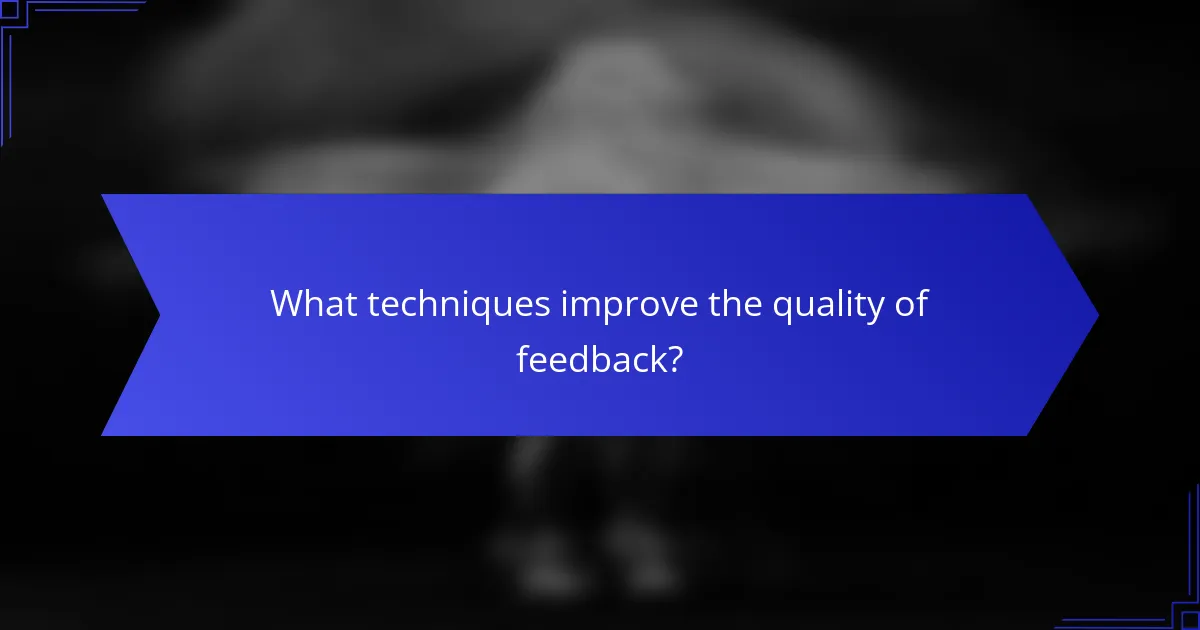
What techniques improve the quality of feedback?
To enhance the quality of feedback for art exhibitions, employing specific techniques can yield more insightful and actionable responses. Techniques such as open-ended questions, offering incentives, and conducting focus groups are effective methods to gather detailed and meaningful feedback.
Open-ended questions for detailed responses
Open-ended questions encourage participants to provide comprehensive feedback rather than simple yes or no answers. For example, asking “What did you find most engaging about the exhibition?” invites deeper reflection and richer insights.
When crafting these questions, aim for clarity and relevance to the exhibition’s themes. Avoid leading questions that may bias responses. A good practice is to include a mix of open-ended and closed questions to balance depth and ease of analysis.
Incentives for participation
Offering incentives can significantly boost participation rates in feedback surveys. Incentives can range from small tokens, like discounts on future exhibitions, to entries into a raffle for larger prizes. This approach not only motivates attendees but also shows appreciation for their time.
Consider the cost of incentives in relation to the potential value of the feedback received. Ensure that the incentives align with your audience’s interests to maximize engagement. For instance, art-related rewards may resonate more with art enthusiasts.
Focus groups for in-depth discussions
Focus groups provide a platform for in-depth discussions among a select group of participants, allowing for a deeper exploration of their experiences. These sessions can reveal nuanced opinions and collective insights that surveys might miss.
To conduct effective focus groups, select a diverse group of participants that reflects your audience. Prepare a structured guide with key topics to discuss, but remain flexible to explore unexpected themes that arise during the conversation. Aim for sessions lasting between one to two hours to maintain engagement without overwhelming participants.
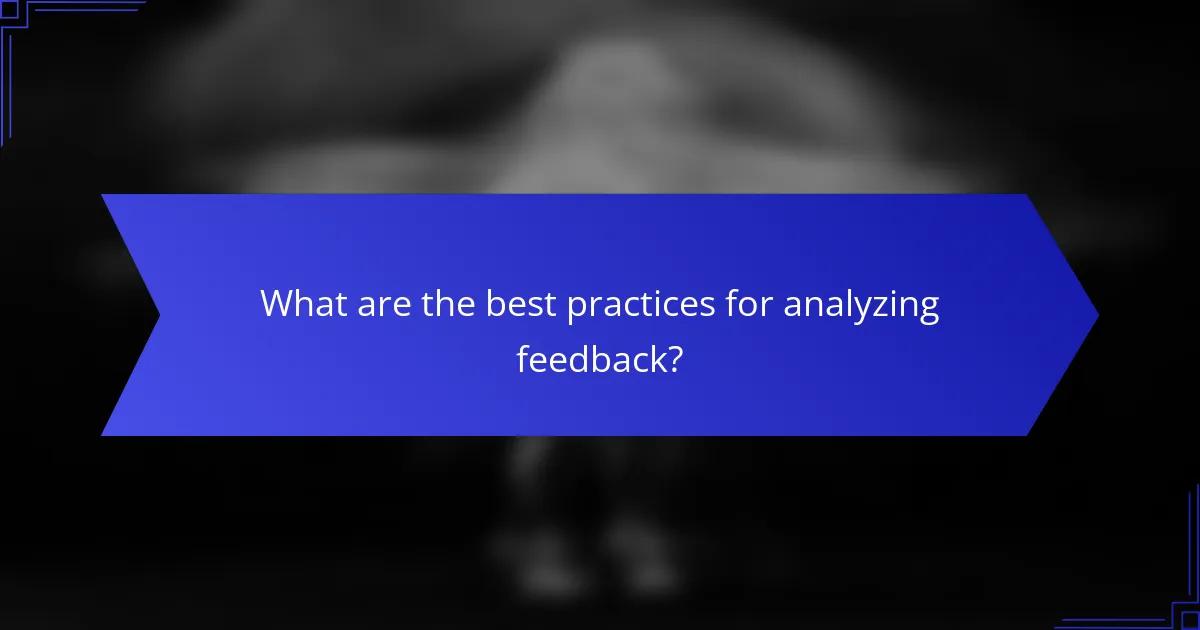
What are the best practices for analyzing feedback?
Best practices for analyzing feedback include utilizing both quantitative and qualitative methods to gain a comprehensive understanding of audience responses. By combining measurable data with thematic insights, you can identify trends and areas for improvement in your art exhibitions.
Quantitative analysis for measurable insights
Quantitative analysis involves collecting numerical data from feedback forms, surveys, or attendance figures. This method allows you to measure aspects such as visitor satisfaction scores, average ratings, and demographic information.
To effectively conduct quantitative analysis, consider using tools like Google Forms or SurveyMonkey to gather responses. Aim for a sample size that represents at least 10-20% of your total audience to ensure reliability. Analyze the data using basic statistical methods to identify trends and patterns.
Thematic analysis for qualitative data
Thematic analysis focuses on identifying recurring themes and sentiments in open-ended feedback. This approach helps to uncover deeper insights into visitor experiences and perceptions of the exhibition.
To perform thematic analysis, categorize comments into themes such as “artistic quality,” “visitor engagement,” or “venue atmosphere.” Use software like NVivo or manual coding to organize the data. Look for common phrases or sentiments that can inform future exhibitions.
Benchmarking against previous exhibitions
Benchmarking involves comparing feedback from the current exhibition to that of previous ones. This practice helps to assess progress and identify consistent strengths or weaknesses over time.
Collect data from past exhibitions and establish key performance indicators (KPIs) such as visitor numbers, average ratings, and specific feedback themes. By analyzing changes in these metrics, you can make informed decisions about future programming and marketing strategies.
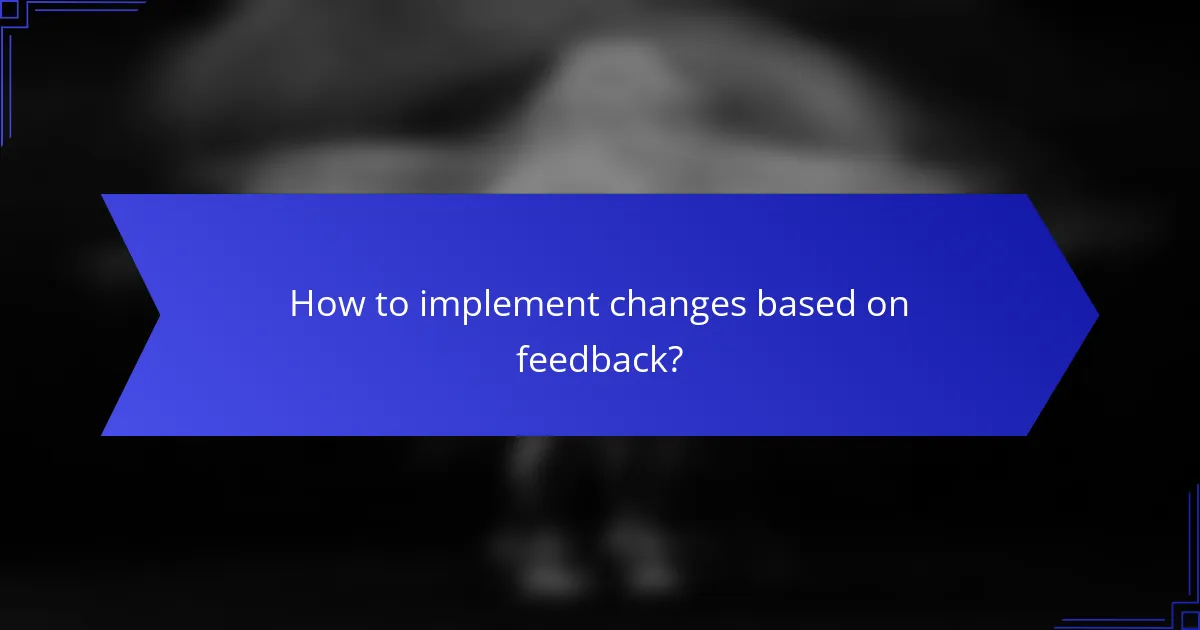
How to implement changes based on feedback?
Implementing changes based on feedback involves analyzing the input received and making informed adjustments to improve future art exhibitions. This process requires a systematic approach to ensure that the changes align with audience expectations and enhance overall experience.
Collecting feedback effectively
To collect feedback effectively, use a combination of methods such as surveys, interviews, and comment cards. Surveys can be distributed digitally or in print, allowing attendees to share their thoughts anonymously. Aim for a diverse range of responses to capture different perspectives.
Consider using open-ended questions alongside multiple-choice options to gather qualitative insights. For example, ask visitors what they enjoyed most and what could be improved. This dual approach provides both quantitative data and detailed comments for deeper analysis.
Analyzing feedback
Analyzing feedback involves identifying common themes and trends from the collected data. Start by categorizing responses into positive and negative feedback, then look for recurring suggestions or complaints. This will help prioritize which changes to implement first.
Utilize tools like spreadsheets or specialized software to visualize data, making it easier to spot patterns. For instance, if multiple visitors mention poor lighting as an issue, it becomes a clear area for improvement in future exhibitions.
Implementing changes
Once feedback has been analyzed, create a plan for implementing changes. Prioritize adjustments based on their potential impact and feasibility. For example, if visitors request more interactive displays, consider incorporating technology like touchscreens or augmented reality.
Communicate planned changes to your team and stakeholders to ensure everyone is aligned. Set realistic timelines for implementation and monitor progress to ensure that changes are made effectively and efficiently.
Evaluating the impact of changes
After implementing changes, it’s crucial to evaluate their impact on future exhibitions. Use follow-up surveys to assess whether the adjustments have improved visitor satisfaction. Compare new feedback with previous data to measure progress.
Consider conducting focus groups with attendees to gather in-depth insights on the changes made. This ongoing evaluation helps refine your approach and ensures that future exhibitions continue to evolve based on audience needs.
